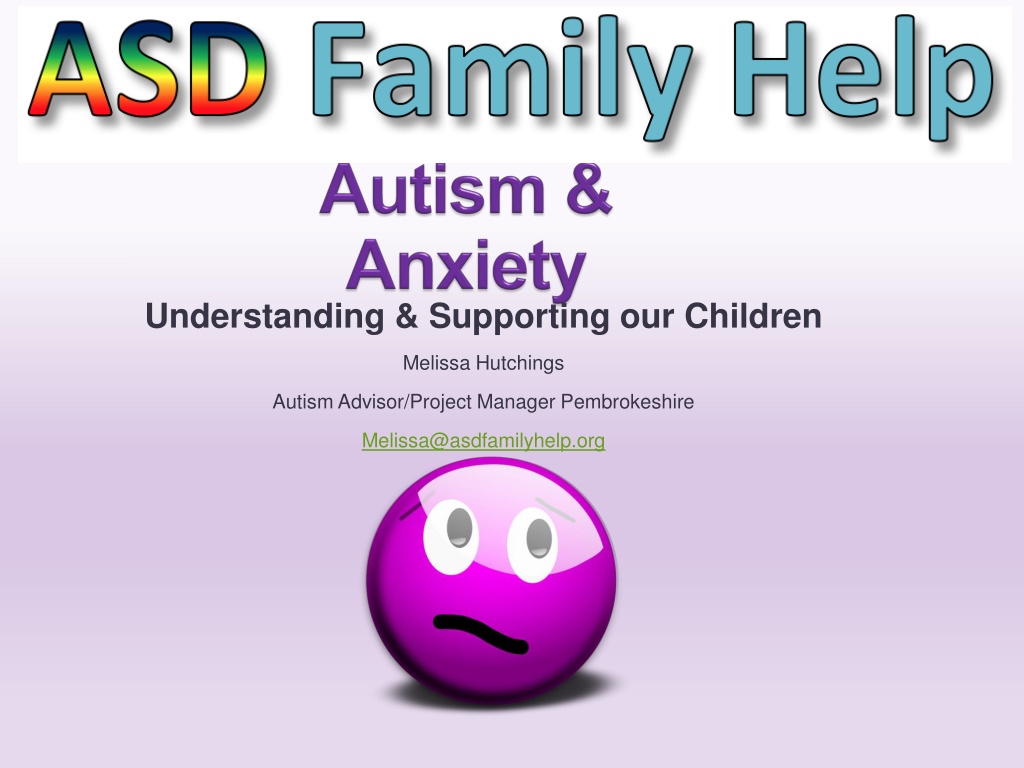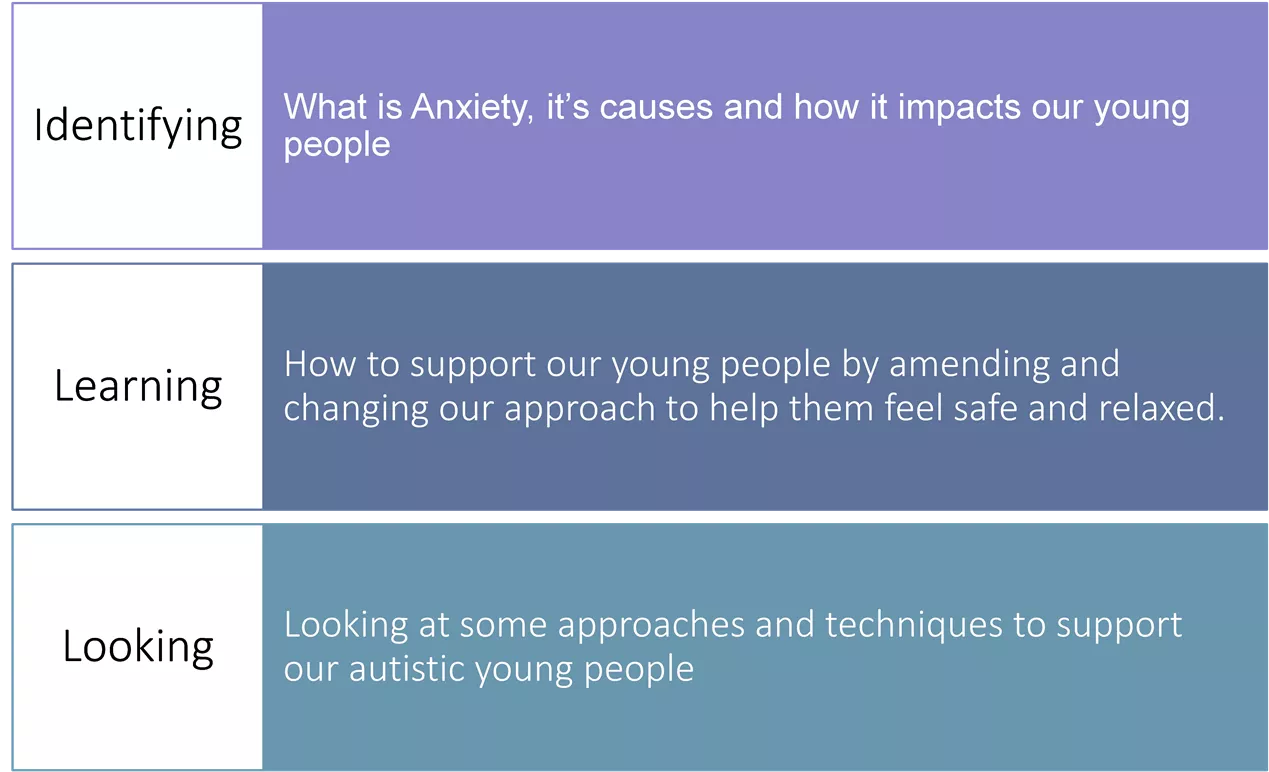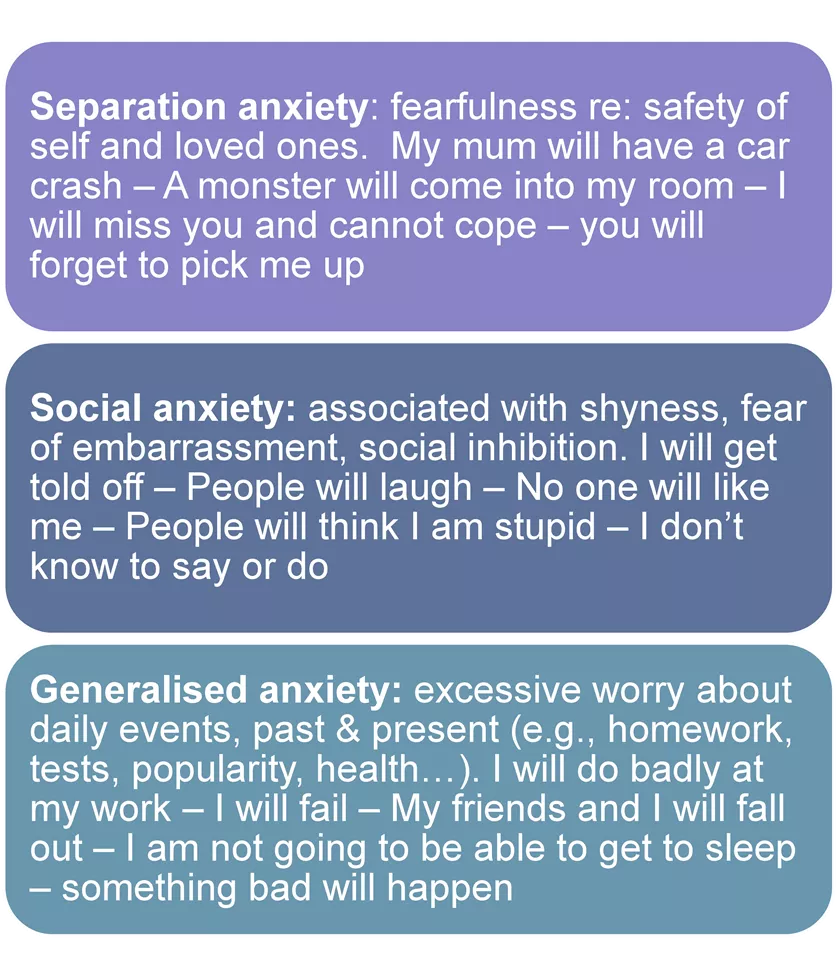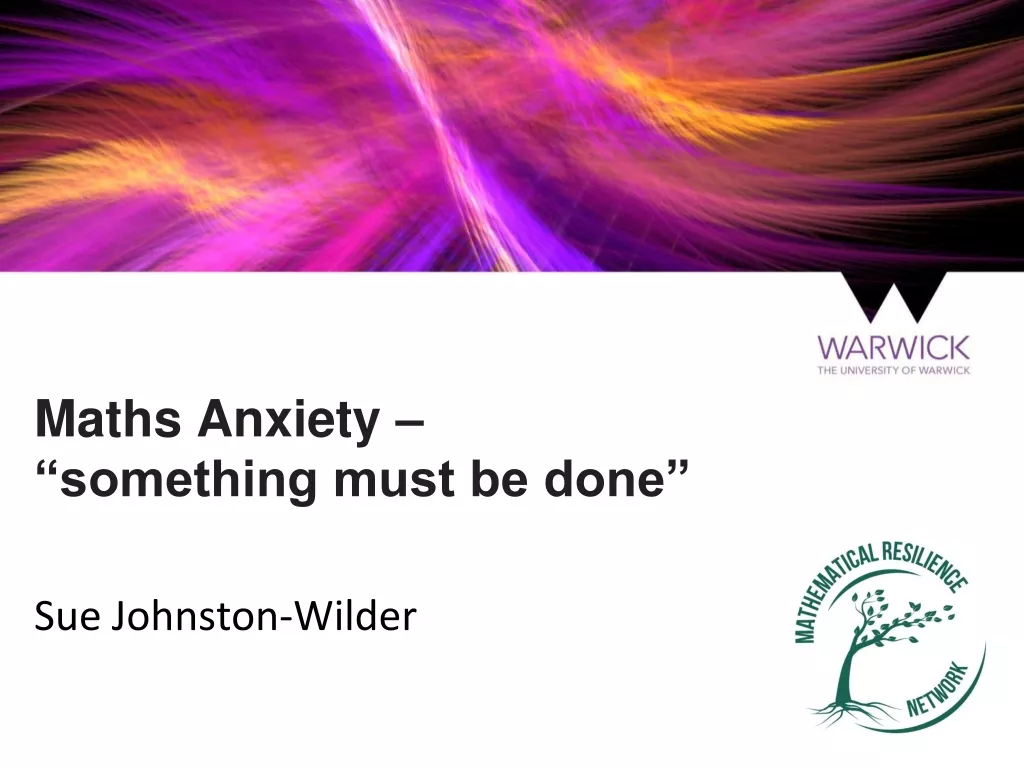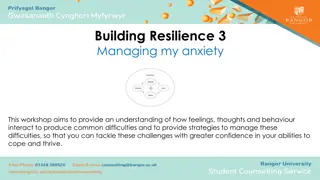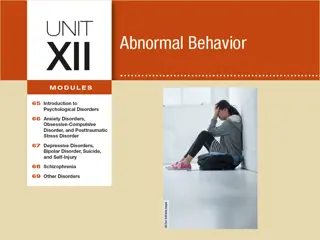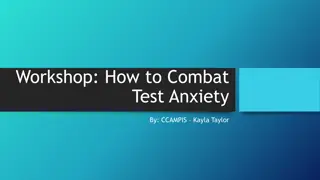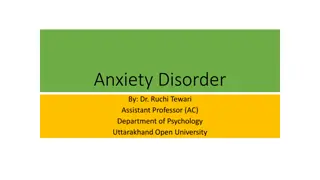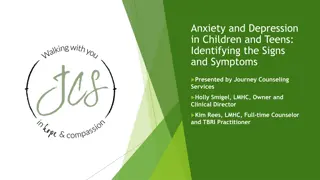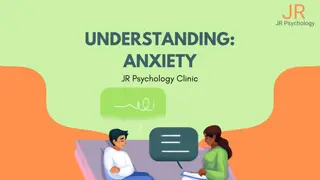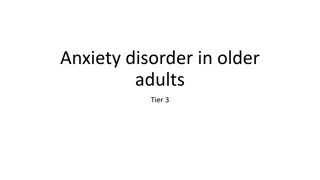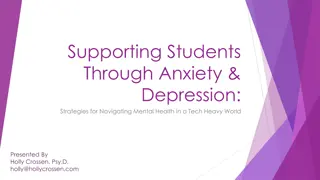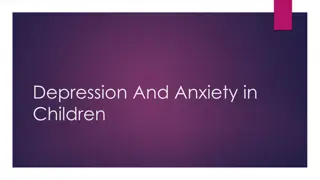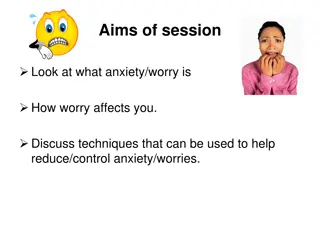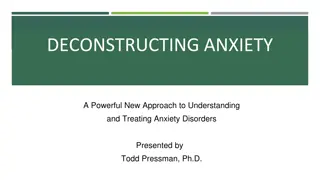Supporting Children with Anxiety
Anxiety can impact children in various ways, affecting their daily life and relationships. Learn about different types of anxiety, causes, and how to provide support. Explore the connection between anxiety and performance, reasons for children becoming anxious, and strategies to help them cope effectively.
Download Presentation

Please find below an Image/Link to download the presentation.
The content on the website is provided AS IS for your information and personal use only. It may not be sold, licensed, or shared on other websites without obtaining consent from the author.If you encounter any issues during the download, it is possible that the publisher has removed the file from their server.
You are allowed to download the files provided on this website for personal or commercial use, subject to the condition that they are used lawfully. All files are the property of their respective owners.
The content on the website is provided AS IS for your information and personal use only. It may not be sold, licensed, or shared on other websites without obtaining consent from the author.
E N D
Presentation Transcript
Understanding & Supporting our Children Melissa Hutchings Autism Advisor/Project Manager Pembrokeshire Melissa@asdfamilyhelp.org
Learning Objectives Learning Objectives What is Anxiety, it s causes and how it impacts our young people Identifying How to support our young people by amending and changing our approach to help them feel safe and relaxed. Learning Looking at some approaches and techniques to support our autistic young people Looking
Something we all experience a feeling of worry, nervousness, or unease about something with an uncertain outcome: (oxford dictionary) Everybody experiences anxiety at some point in time. It becomes a problem when it STOPS your child from enjoying normal life by affecting their school, work, family relationships, friendships or social life
Separation anxiety: fearfulness re: safety of self and loved ones. My mum will have a car crash A monster will come into my room I will miss you and cannot cope you will forget to pick me up Different Kinds of Anxiety Social anxiety: associated with shyness, fear of embarrassment, social inhibition. I will get told off People will laugh No one will like me People will think I am stupid I don t know to say or do Generalised anxiety: excessive worry about daily events, past & present (e.g., homework, tests, popularity, health ). I will do badly at my work I will fail My friends and I will fall out I am not going to be able to get to sleep something bad will happen
A bit of worry can help us it can enhance our performance, by making us more alert and tasked-focused. Relationship between Anxiety & Performance However too much anxiety over a longer period of time can begin to interfere with our performance. Our ability to concentrate diminishes as we shift away from the task. When anxiety overstays it s welcome, exhaustion results. Which can lead to burnout / shut down / meltdown We are not designed to perform well under these conditions
Why do children become anxious? Often, we develop anxiety following a series of stressful life events so this can include school as well as family issues We do have to consider the ALN as well their own sensitivities Anxious people tend to expect the worst scenario will always occur. So, find it hard to relax Temperament Life events Our children will pick up on our own anxieties. Thinking styles Parent anxiety Child anxiety Learning experiences Genes When we are under threat or feel danger. It helps us with our fight & flight preparing us for a quick response It has also been suggested that anxiety has family ties.
Separation difficulties Volume controlling Self-harming Burnouts / Exhaustion Withdrawing from social contacts/activities Destructive behaviour /anger/ everything is boring! Headaches / tension Inappropriate laughter Sensory seeking Tearful Sleep Issues Increase use of toilet Eating issues Feeling irritability or down Increase in obsessions School Non attending Repetitive questions Dealing with change Tummy aches Avoidance or refusals Masking / Shutting down
Learning to Beat Anxiety Remember there are times when we ALL feel worried, anxious, uptight or stressed. This is NORMAL and often there is a reason. Other times these feelings can feel so strong that they take over and my STOP us from doing the things you want to or must do in life. We just want to hide When this happens, we try to take control and learn how to beat these feelings. Often our children lose control, become overwhelmed and distressed, help and guide them with this. There can be days of the build-up and then afterwards days to feel better.
Ideas and tips to think about Modify your expectations - When things don t meet your expectations, it can lead to negative feelings. Consider their emotional age and what they can do beware of the level of your child s needs. Modify the environment be aware of your child's sensory difficulties the environment often can play a big part in anxiety Look at how you can support their executive functioning skills Present it visually timetables, write lists, create structure. It helps to take away uncertainty. Make some parts of the day that always happen the same time in the same way Let them know, how long, where and when Let them know what to expect - be honest Let them know you are there and on their side / collaborate with them Be available to play and talk to them Prepare - if you think something is going to be problematic
Helping Your Child With Fears Helping Your Child With Fears and Worries and Worries Addresses specific fears and phobias as well as general anxiety and 'worrying'. Provides step-by-step practical strategies. Includes case studies, worksheets and charts. Encourages you to help your child problem solve for themselves Based on the authors' experience at their anxiety disorders clinic at the University of Reading and developed from a programme based on working almost exclusively with parents.
There are five steps to help There are five steps to help your child overcome their your child overcome their fears: fears: 1st Step: understanding your child and their anxiety What makes your child anxious? What are the signs that you have noticed? How does it feel in their body? Identifying and recognising them in your child can really help. Put together visuals to help them understand you may have to work on their emotional regulation skills
Step 1: Talk about Fears and worries Step 1: Talk about Fears and worries Encourage your child to be open about any fears and worries - This won t make it worse, be honest and accurate. However, listen, please do not judge, long pauses are ok. Encourage them to talk freely . They may struggle to explain what is happening or what they are feeling, but may expect you to understand Tell them what makes you anxious when you were young Ask them what makes them worry, using open questions. What do they think will happen? You can look at the evidence Use comic strip conversations or social stories or just general drawing / doodling on a page can help Give an older child a feelings journal Music (lyrics) may help/poetry/ images google or books Timing and the way you ask are important considerations. Sometimes take the worry away for them Your empathy will increase the chances that your child will accept your guidance and discuss his or her fears with you in the future.. Try not to be critical or express frustration. Accept their worries are real for them. Sometimes we do not have the answers, we can only be there to support them and acknowledge how they feel
https://reconnect-psych.com.au/wp-content/uploads/2013/04/Anxiety-Gingerbread-man3.jpghttps://reconnect-psych.com.au/wp-content/uploads/2013/04/Anxiety-Gingerbread-man3.jpg Draw a gingerbread person and give it a name. Get the young person to draw/write on the person all the physical things they notice about what happens when they are worried/anxious.
Try using Phrases like: Try using Phrases like: Using phrases that reassure a child they are physically and emotionally safe can be deeply reassuring. Acknowledging and validating how a child feels without trying to explain or dismiss it can be very powerful. That must be really hard I m here. I ve got you It s okay, you re safe I m going to stay with you You re going to be okay It s okay to cry You re not in trouble I m sorry that X is making you anxious Let's begin to unpick your worry Do you want to talk about it? You're worried, how can I help? It s not silly, if it s making you feel like this Autistic people often seek tangible answers, because they may lack executive functioning skills, the immediate need is not an emotional one, try and give a practical one, with solutions / choices or a backup plan.
Too much can lead to more anxiety! No matter how much reassurance you give, an anxious child sometimes they want more. It only relieves your child s anxiety in the moment. Does hearing Don t worry. Relax!" help you when you're anxious about something? It probably doesn't comfort your child much, either. It s important to acknowledge that your child s fears are real. You may like to . Distract / redirect if you can See if they can produce the answer Let them know that others can feel that way to - Normalising Work together for a solution/plan/scaffold Present suggestions as a question rather than a statement so they can say no, that is not what I am worried about Write it down: Social story, Comic strip Conversations/post it notes Check you have understood reflect back Pick your timing try and make it fun (if you can)
Step 3: Encourage them.... Builds on self-esteem and confidence Encourage them to become more independent, try not to do everything for them or feel you must fix it, walk alongside them. Show them what to do let them know they have got this. Make sure they feel safe, and they do have autonomy Break the task down with them, so they can achieve what can you change to help make it work. I feel this as well, its tricky, together we can do this Believe in them, praise small attempts as well as big ones (make praise clear and specific). Celebrate success. Give rewards, rewards can also offer further encouragement if you feel this will help.
Step 3: Lead by example Using positive language take out negative comments about them/ the situation, try not to feed the anxiety Try and stay relaxed and connected with your child, what are they trying to communicate to you? Beware of showing your own fears and anxieties Model being brave, show them, show them! Don t expect children to know when to ask for help and don t expect them to know what they are thinking /worrying about Make time to have fun and laugh together
Discourage Avoidance A natural reaction to a threat is to get away from it. In the short term this is the best solution, however, by not facing your fears you never learn whether you can overcome it or was it really that bad! Try not to let them avoid too much, encourage Have a go even for 5 minutes. Break it down, scaffold the task. Do it together to start off with. Take teeny tiny steps, so that failure is very unlikely This will help build confidence and self esteem Remember It s ok to acknowledge the fear It's also ok for them to say No and we try another day Remember how can we make them feel safe and have autonomy to lead to better independence
Step 4: Step Ladder Approach Reducing anxiety when facing a worry or fear The step-ladder approach for the treatment of anxiety is medically known as graded or hierarchical exposure.(Step by Step) It s one of the behavioural components of cognitive-behavioural therapy (CBT) and it s useful to know about when encouraging your child to address their fears. This step-by-step approach allows your child to practice coping with their anxiety in manageable doses. In this way, your child also experiences successes along the way which builds up their confidence and sense of achievement.
Going up stairs on my own I stay upstairs for 5 mins I walk upstairs and into my room on my own I walk up to the top of stairs on my own Mum stands at bottom of stairs I go to the top Mum stands at bottom of stairs, I go up half way
Step 5: Learn to Problem solve Help your child recognise anxiety become detectives and look a possible solutions and how they can have ago Teach them about self-regulation skills .about emotions/ feelings / how their body feels Teach the autistic child what it means to be autistic Use the 5 point scale / Zones of regulation Comic Strip Conversations Social Stories Visuals Model bravery and role play
Teach Relaxation techniques to help manage the physical symptoms of anxiety Having fun and laughter www.actionforhappiness.org Deep breathing techniques Box / Belly 5 Things you can see, 4 Things you can hear, 3 Things you can touch, 2 Things you can smell, 1 deep cleansing breath. Mindfulness Encourage children to think of happy memories show photos make scrab books Exercise Listening to and playing music Spend time with friends and family Cuddle with pets and loved ones Doing these things together can help.
Stage 5: what can I do about it? Produce a list of ideas with your child remember baby steps lead to bigger steps what works, what doesn t work, what is important to them and what isn t Make a Self Soothe bags and Happy Boxes can be a good here, and lists, or Velcro choice boards can work too. Calm spaces, breathing, relaxation exercises, Make it visual The Aim: Is for your child to know what helps them relax and bring them back down to a 2 or a 1
A Hug Chill out Zone Time alone door signs not in the mood leave me alone! Rating scales Colours, Numbers, Physical Activities Talk things through Staying calm/relaxed yourself do look after yourself Sensory snacks Controlled Breathing Deep Pressure Write or draw things down Listen to loud Music Put Together Visuals to help them remember
Just a few other links of support Just a few other links of support If you become concerned always contact your doctor or call 111 option 2 for professional help and guidance www.mind.org.uk www.youngminds.org.uk www.charliewaller.org www.childline.org.uk
Thank you for listening Thank you for listening Any questions? Any questions?
